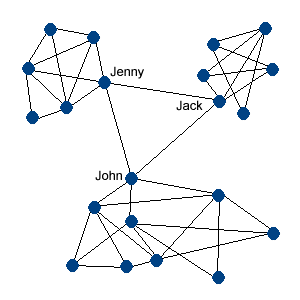Why is it that two football teams whose players have similar abilities can perform very differently? Because performance depends not only on the quality of the single players, but on the relationships and interactions between them. In an organisational setting, poor informal rela tionships can make or break change, strangle innovation, and cripple day to day operations.
tionships can make or break change, strangle innovation, and cripple day to day operations.
The problem is that informal relationships and interactions are often poorly understood and masked by the fiction of a formal structure, which is often represented by a neat, hierarchical wire diagram. The purpose of SNA is to understand how this informal structure operates in conjunction with the formal structure and workflow. This can be done very powerfully using visualisation software to create a 2D picture, but for small teams, with 8-12 members, insights can also be gained using a pen and paper.
The basic assumptions of SNA are threefold: first, that personal relationships have a big impact on productivity; second, that human network maps (sociograms) help us visualize and understand where an organization is resilient and strong, and where it is vulnerable and weak; and third, that we can analyse these maps to identify flows of information, knowledge and trust, which will help plan organizational improvement. In short, by visualizing and analyzing informal social networks managers can bring out the strengths in their networks, restructure their formal organizations to complement the informal and ‘rewire’ faulty networks to achieve company goals.
To get a good overall picture of the informal networks in your organization you typically need to visualize three types of relationship networks:
- Communication networks reveal who talks to whom about work related matters on a regular basis. Mapping communication networks can help identify gaps in information flow, inefficient use of resources and the failure to generate new ideas.
- Advice networks show the prominent members in an organization on whom others depend to solve problems and provide technical information. These networks show influential players in the day-to-day operations of a company and are useful to examine when a company is considering routine changes.
- Trust networks show who employees share delicate political information with and who they back in a crisis. Mapping trust networks will uncover the source of political conflicts and failure to achieve strategic objectives. You should examine trust networks when implementing a major change or experiencing a crisis.
Now, try it with your pen and paper. For each of the three types start with the person you think is most connected, put them in the centre of the page and the other team members around them, then connect the dots. Try to be honest, you may not be at the centre of every universe. If you’re stuck try talking to your subordinates and colleagues and see what they think. After all, those conversations may turn out to be valuable in their own right.




